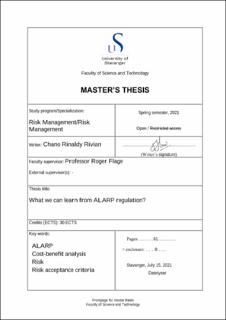What we can learn from ALARP regulation?
Master thesis
Permanent lenke
https://hdl.handle.net/11250/2786368Utgivelsesdato
2021Metadata
Vis full innførselSamlinger
- Studentoppgaver (TN-ISØP) [1410]
Sammendrag
Potential hazards exist in almost all workplaces. The existence of these hazards can result in accidents or incidents that have an impact on people, equipment, materials, and the environment. To get the proper and good decisions regarding risks in the workplace, a risk level or risk priority is determined. The level of risk is used as a management tool in making a decision; therefore, the priority scale can be determined. In determining the priority problem, the ALARP (As Low As Reasonably Practicable) principle can be used. Risk criteria are carried out as a basis for controlling hazards and making decisions to appropriate safety system to be used. The purposes of this thesis contain as the following; 1) Review relevant literature related to the ALARP regulation from various countries, 2) To study and analyze policy documents related to the ALARP regulation, 3) To investigate the understanding of the similarities and differences in ALARP regulation from one country to another. The use of ALARP in various countries prompted this thesis; General ALARP regulations from certain countries were selected as case studies and represent the regulations for the same industry. Regulations from several countries have their own advantages and disadvantages, but the point is that the risk must be reduced to a level that is as low as reasonably practicable. The use of ALARP from the five countries, namely Norway, the United Kingdom, Denmark, Australia, and Singapore, the format of using the ALARP principle has a different approach across these countries will be interesting topics to discuss.
Keywords: ALARP, Cost-benefit analysis, Risk, Risk Acceptance Criteria
